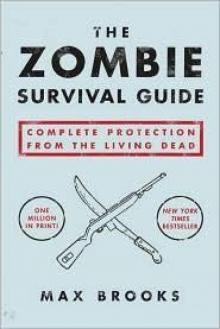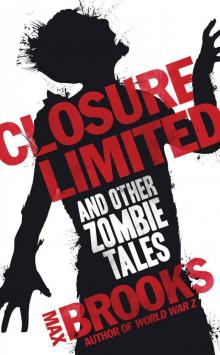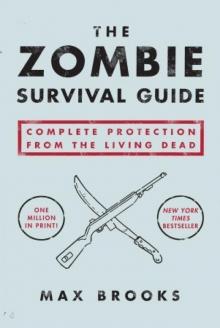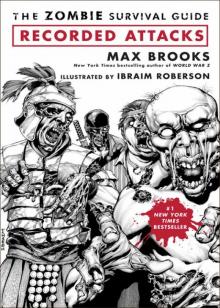- Home
- Max Brooks
The Zombie Survival Guide: Complete Protection From the Living Dead Page 18
The Zombie Survival Guide: Complete Protection From the Living Dead Read online
Page 18
Obeidallah’s research documented the entire physiology of the living dead. His notes included reports on the nervous system, digestion, even the rate of decomposition in relation to the environment. This work also included a complete study of the behavioral patterns of living dead, a remarkable achievement if actually true. Ironically, when Christian knights stormed Jerusalem in 1099, this amazing man was beheaded as a worshiper of Satan, and almost all of his work was destroyed. Sections of it survived in Baghdad for the next several hundred years, with only a fraction of the original text rumored to survive. Obeidallah’s life story, however, minus the details of his experiments, survived the crusaders’ slaughter, along with his biographer (a Jewish historian and former colleague). The man escaped to Persia, where the work was copied, published, and gained modest success in various Middle Eastern courts. A copy remains in the National Archives in Tel Aviv.
1253 A.D., FISKURHOFN, GREENLAND
Following the great tradition of Nordic exploration, Gunnbjorn Lundergaart, an Icelandic chieftain, established a colony at the mouth of an isolated fjord. There were reported to be 153 colonists in the party. Lundergaart sailed back to Iceland after one winter, presumably to procure supplies and additional colonists. After five years, Lundergaart returned to find the island compound in ruins. Of the colonists, he found just three dozen skeletons, the flesh picked clean from the bones. It is also reported that he encountered three beings, two women and one child. Their skin was a mottled gray, and bones stuck through the flesh in places. Wounds were evident, but no traces of blood could be observed. Once sighted, the figures turned and approached Lundergaart’s party. Without responding to any verbal communication, they attacked the Vikings and were immediately chopped to pieces. The Norseman, believing the entire expedition was cursed, ordered the burning of all bodies and artificial structures. As his own family were among the skeletons, Lundergaart ordered his men to kill him as well, dismember his body, and add it to the flames. The “Tale of Fiskurhofn,” told by Lundergaart’s party to traveling Irish monks, survives in the national archives in Reykjavik, Iceland. Not only is this the most accurate account of a zombie attack within ancient Nordic civilization, it may also explain why all Viking settlements within Greenland mysteriously vanished during the early fourteenth century.
1281 A.D., CHINA
The Venetian explorer Marco Polo wrote in his journal that during one visit to the emperor’s summer palace of Xanadu, Kublai Khan displayed a severed zombie head preserved in a jar of clear alcoholic fluid (Polo described the fluid as “with the essence of wine but clear and biting to the nose”). This head, the Khan stated, had been taken by his grandfather, Genghis, when he returned from his conquests in the West. Polo wrote that the head was aware of their presence. It even watched them with nearly decomposed eyes. When he reached out to touch it, the head snapped at his fingers. The Khan chastised him for this foolish act, recounting the tale of a low-ranking court official who had tried the same thing and had been bitten by the severed head. This official later “seemed to die within days but rose again to attack his servants.” Polo states that the head remained “alive” throughout his stay in China. No one knows the fate of this relic. When Polo returned from Asia, his story was suppressed by the Catholic Church and therefore does not appear in the official publication of his adventures. Historians have theorized that, since the Mongols reached as far as Baghdad, the head may be one of the original subjects of Ibrahim Obeidallah, which would entitle the head to the record of the best-preserved, oldest “living” relic of a zombie specimen.
1523 A.D., OAXACA, MEXICO
The natives tell of a sickness that darkens the soul, causing a thirst for the blood of their brothers. They tell of men, women, even children whose flesh have become gray with rot and possess an unholy smell. Once darkened, there is no method of healing, save death, and that can only be achieved through fire, since the body becomes resistant to all arms of man. I believe this to be a tragedy of the heathen, for, without their knowledge of Our Lord Jesus Christ, there was indeed no cure for this illness. Now that we have blessed their masses with the light and truth of His love, we must strive to seek these darkened souls, and cleanse them with all the force of Heaven.
This text was, supposedly, taken from the accounts of Father Esteban Negron, a Spanish priest and student of Bartolome de las Casas, previously edited from the original works and recently discovered in Santo Domingo. Opinions vary on the authenticity of this manuscript. Some believe it to be a part of a Vatican order to suppress all information on the subject. Others believe it to be an elaborate hoax along the lines of the “Hitler diaries.”
1554 A.D., SOUTH AMERICA
A Spanish expedition under the command of Don Rafael Cordoza penetrated the Amazon jungle in search of the fabled El Dorado, the City of Gold. Tupi guides warned him not to enter an area known as “The Valley of Endless Sleep.” In it, they cautioned, he would find a race of creatures who moaned like wind and thirsted for blood. Many men had entered this valley, said the Tupi. None ever returned. Most of the conquistadors were terrified by this warning and begged to return to the coast. Cordoza, believing that the Tupi had fabricated this story in order to hide the golden city, pushed his expedition forward. After dark, the camp was attacked by dozens of walking dead. What transpired that night is still a mystery. The passenger manifest from the San Varonica, the ship that carried Cordoza from South America to Santo Domingo, has shown that he was the only survivor to reach the coast. Whether he fought to the end or simply abandoned his men, no one knows. A year later, Cordoza reached Spain, where he provided a full account of this attack to both the Royal Court in Madrid and the Holy Office in Rome. Accused of squandering crown resources by the Royal Court, and of speaking blasphemous acts by the Vatican, the conquistador was stripped of his title and died in obscure poverty. His story is a compilation of fragments from many texts concerning this period in Spain’s history. No original work has been discovered.
1579 A.D., THE CENTRAL PACIFIC
During his circumnavigation of the globe, Francis Drake, the pirate who later became a national hero, stopped at an unnamed island to restock his supplies of food and fresh water. The natives warned him not to visit a small, nearby cay that was inhabited by “the Gods of the Dead.” According to custom, the deceased and terminally ill were placed on this island, where the gods would take them, body and soul, to live on forever. Drake, fascinated by their story, decided to investigate. Observing from aboard ship, he watched as a native shore party placed the body of a dying man on the island’s beach. After blowing several calls from a conch shell, the natives retreated to the sea. Moments later, several figures staggered slowly out of the jungle. Drake watched them feed on the corpse before slouching out of sight. To his amazement, the half-eaten body rose to its feet and hobbled after them. Drake never spoke of this incident during his life. The facts were discovered in a secret journal he kept hidden until his death. This journal, passing from one personal collector to another, eventually found its way into the library of Admiral Jackie Fischer, the father of the modern Royal Navy. In 1907 Fischer had it copied and gave it to several of his friends as a Christmas gift. Along with exact coordinates, Drake proclaimed this landmass “the Isle of the Damned.”
1583 A.D., SIBERIA
A scouting party for the infamous Cossack Yermak, lost and starving in the frozen wild, was sheltered by an indigenous, Asiatic tribe. Once they had recovered their strength, the Europeans repaid the kindness by declaring themselves the rulers of the village, and settled down for the winter until Yermak’s main force arrived. After feasting for several weeks on the village’s stored food, the Cossacks now turned their hunger upon the villagers themselves. In a savage act of cannibalism, thirteen people were eaten, while the others fled into the wilderness. The Cossacks went through this new source of food within days. In desperation, they turned to the village burial ground, where, it was believed, the freezing temperatures had preserved any fr
esh corpses. The first body exhumed was a woman in her early twenties, who had been buried with her hands and legs bound and her mouth gagged. Once defrosted, the dead woman revived. The Cossacks were astounded. Hoping to learn how she had achieved such a feat, they removed her gag. The woman bit one Cossack on the hand. With continued shortsightedness, ignorance, and brutality, the Cossacks dismembered, roasted, and ate her flesh. Only two abstained: the wounded warrior (it was believed by his comrades that food should not be wasted on the dying) and a deeply superstitious man who believed the meat to be cursed. In a manner of speaking, he was right. All who ate the zombie’s flesh died that night. The wounded man expired the next morning.
The one survivor attempted to burn the bodies. As he was preparing a funeral pyre, the bitten corpse revived. With the new zombie in hot pursuit, the lone survivor took off across the steppe. Barely an hour into the chase, the exposed zombie froze solid. The Cossack wandered for several days until he was rescued by another scouting party from Yermak. His account was documented by a Russian historian, Father Pietro Georgiavich Vatutin. The work remained obscure for several generations, housed in the remote monastery on Valam Island on Lake Ladoga. It is only now being translated into English. Nothing is known of the fate of the Asiatic villagers or even what their true identity is. The subsequent genocide against these people by Yermak left few survivors. From a scientific point of view, this account represents the first known occurrence of a zombie freezing solid.
1587 A.D., ROANOKE ISLAND, NORTH CAROLINA
English colonists, isolated from any support from Europe, sent regular hunting parties to the mainland in search of food. One of these parties disappeared for three weeks. When a lone survivor returned, he described an attack by “a band of savages . . . their putrid, worm-ridden skin impervious to powder and shot!” Although only one of the eleven-man party was killed, four of the others were savagely mauled. These men died the following day, were buried, then rose from their shallow graves within hours. The survivor swore that the remainder of his party was eaten alive by his former comrades, and that he alone escaped. The colony magistrate declared the man both a liar and a murderer. He was hanged the next morning.
A second expedition was sent to recover the bodies “lest their remains be desecrated by heathens.” The five-man party returned in a state of near collapse, bite and scratch marks covering their bodies. They had been attacked on the mainland, both by the “savages” described by the now-vindicated, deceased survivor, and also by members of the first hunting party. These new survivors, after a period of medical examination, passed away within hours of each other. Burial was set for the following dawn. That night, they reanimated. Details are sketchy as to the rest of the story. One version describes the eventual infection and destruction of the entire town. Another has the Croatan Nation, recognizing the danger for what it was, rounding up and burning every colonist on the island. In a third account, these same Native Americans rescued the surviving townspeople and dispatched the undead and wounded. All three stories have appeared in fictional accounts and historical texts for the last two centuries. None presents an airtight explanation as to why the first English settlement in North America literally vanished without a trace.
1611 A.D., EDO, JAPAN
Enrique Desilva, a Portuguese merchant doing business in the islands, wrote this passage in a letter to his brother:
Father Mendoza, reacquainting himself with Castillian wine, spoke of a man who has recently converted to our faith. This Savage was a member of one of the most secretive orders in this exotic, barbaric land, “The Brotherhood of Life.” According to the old clergyman, this secret society trains assassins for, and I speak in all sincerity, the purpose of executing demons. . . . These creatures, from his explanation, were once human beings. After their death, some unseen evil caused them to arise . . . feasting upon the flesh of the living. To combat this terror, “The Brotherhood of Life” has been formed, according to Mendoza, by the Shogun himself. . . . They are taken from an early age . . . trained in the art of destruction. . . . Their strange manner of unarmed battle devotes much time to avoiding manhandling by the demons, wriggling as does a snake to avoid being seized. . . . Their weapons, oddly shaped Oriental scimitars, are designed for the severing of heads. . . . Their temple, although its location remains the utmost secret, is said to possess a room where the live and still-wailing heads of destroyed monsters adorn the walls. Senior recruits, primed for their ascension into the brotherhood, must spend an entire night in this room, with nothing but the unholy objects for company. . . . If Father Mendoza’s story is true, this land is, as we have always suspected, one of godless evil. . . . Were it not for the lure of silk and spice, we would do well to avoid it at all costs. . . . I asked the old priest where this new convert was, in order to hear the words of this tale from his own lips. Mendoza informed me that he had been found murdered almost a fortnight ago. “The Brotherhood” do not allow their secrets to be spilled, nor their members to renounce their allegiance.
Many secret societies existed in feudal Japan. “The Brotherhood of Life” does not appear in any text, past or present. Desilva does make some historical inaccuracies in his letter, such as referring to a Japanese sword as a “scimitar.” (Most Europeans did not bother with learning any aspects of Japanese culture.) His description of the wailing heads is also an inaccuracy as a severed zombie head could not produce any noise without a diaphragm, lungs, and vocal cords. If his story is true, however, it would explain why there have been few reported outbreaks in Japan as opposed to the rest of the world. Either Japanese culture has produced an effective wall of silence surrounding its outbreaks or the Brotherhood of Life accomplished its mission. Either way, there were no reports of outbreaks in connection with Japan until the mid-twentieth century.
1690 A.D., THE SOUTHERN ATLANTIC
The Portuguese merchantman Marialva left Bissau, West Africa, with a cargo of slaves bound for Brazil. It never reached its destination. Three years later, in the middle of the South Atlantic, the Danish vessel Zeebrug spotted the drifting Marialva. A boarding party was dispatched for the purpose of salvage. They found, instead, a cargo hold of undead Africans still chained to their bunks, writhing and moaning. There was no sign of the crew, and each of the zombies had at least one bite taken from its body. The Danes, believing this ship to be cursed, rowed hastily back to their vessel and reported their findings to the captain. He immediately sank the Marialva with cannon fire. Because there is no way of knowing exactly how the infestation came aboard, all that is left to us is speculation. No lifeboats were found aboard. Only the captain’s body was found, locked in his cabin, with a self-inflicted pistol wound to the head. Many believe that, since the Africans were all chained, the initial infected person must have been a member of the Portuguese crew. If this is true, the unfortunate slaves would have to have endured watching their captors devour or infect one another after their slow transformation into living dead, the virus having worked its way through their systems. Even worse is the awful likelihood that one of these crewmembers attacked and infected a chained slave. This new ghoul, in turn, bit the chained, screaming person next to him. On and on down the line, until the screams were eventually quiet and the entire hold was filled with zombies. Imagining those at the end of the line, seeing their future creeping steadily closer, was enough to conjure the worst nightmares.
1762 A.D., CASTRIES, ST. LUCIA, THE CARIBBEAN
The story of this outbreak is still told today, both by Caribbean islanders and Caribbean immigrants in the United Kingdom. It serves as a powerful warning, not just of the power of the living dead but of humanity’s frustrating inability to unite against them. An outbreak of indeterminate source began in the poor white area of the small, overcrowded city of Castries on the island of St. Lucia. Several free black and mulatto residents realized the source of the “illness” and attempted to warn the authorities. They were ignored. The outbreak was diagnosed as a form of rabies. The first group
of infected people were locked in the town jail. Those who suffered bites while trying to restrain them were sent home without treatment. Within forty-eight hours, all of Castries was in chaos. The local militia, not knowing how to stem the onslaught, was overrun and consumed. The remaining whites fled the city to the outlying plantations. Because many of them had already been bitten, they eventually spread the infection throughout the entire island. By the tenth day, 50 percent of the white population was dead. Forty percent, more than several hundred individuals, were prowling the island as reanimated zombies. The remainder had either escaped by whatever seacraft they could find or remained holed up in the two fortresses at Vieux Fort and Rodney Bay. This left a sizable force of black slaves who now found themselves “free” but at the mercy of the undead.
Unlike the white inhabitants, the former slaves possessed a deep cultural understanding of their enemy, an asset that replaced panic with determination. Slaves on every plantation organized themselves into tightly disciplined hunting teams. Armed with torches and machetes (all firearms had been taken by the fleeing whites) and allied with the remaining free blacks and mulattoes (St. Lucia contained small but prominent communities of both), they swept the island from north to south. Communicating by drum, the teams shared intelligence and coordinated battle tactics. In a slow, deliberate wave, they cleared St. Lucia in seven days. Those whites still within the forts refused to join the struggle, as their racial bigotry matched their cowardice. Ten days after the last zombie was dispatched, British and French colonial troops arrived. Instantly, all former slaves were placed back in chains. Any resisters were hanged. As the incident was recorded as a slave uprising, all free blacks and mulattoes were either enslaved or hanged for aiding in the supposed rebellion. Although no written records were kept, an oral account was passed down to the present day. A monument is rumored to exist somewhere on the island. No resident will testify to its location. If one can take a positive lesson from Castries, it is that a group of civilians, motivated and disciplined, with only the most primitive arms and basic communication, is a formidable match for any zombie attack.

 World War Z: An Oral History of the Zombie War
World War Z: An Oral History of the Zombie War Minecraft: The Island
Minecraft: The Island The Zombie Survival Guide: Complete Protection From the Living Dead
The Zombie Survival Guide: Complete Protection From the Living Dead Closure, Limited and Other Zombie Stories
Closure, Limited and Other Zombie Stories Devolution: A Firsthand Account of the Rainier Sasquatch Massacre
Devolution: A Firsthand Account of the Rainier Sasquatch Massacre The Zombie Survival Guide
The Zombie Survival Guide World War Z
World War Z Closure, Limited
Closure, Limited The Zombie Survival Guide: Recorded Attacks
The Zombie Survival Guide: Recorded Attacks World War Z_An Oral History of the Zombie War
World War Z_An Oral History of the Zombie War The Essential Max Brooks: The Zombie Survival Guide and World War Z
The Essential Max Brooks: The Zombie Survival Guide and World War Z